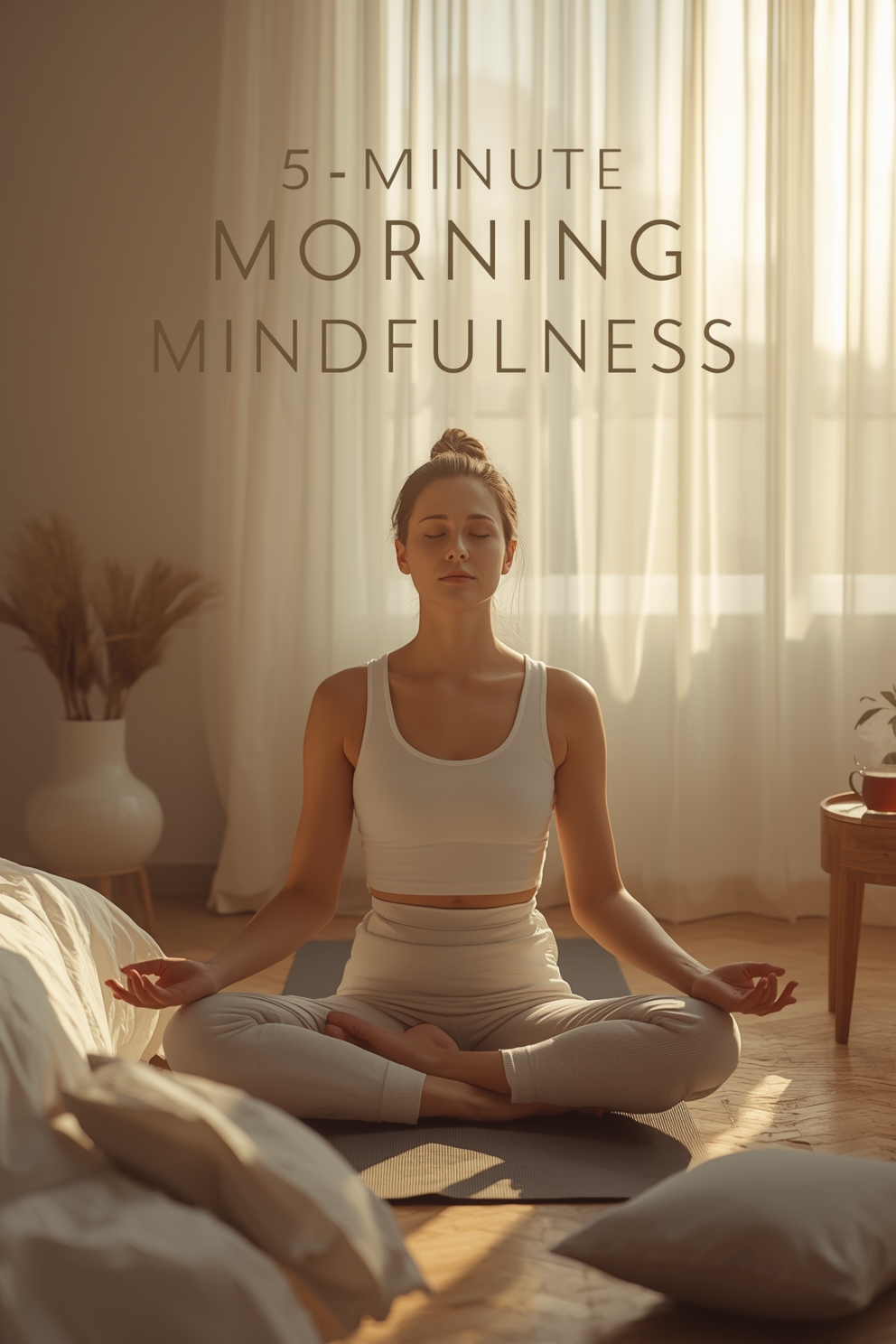Your mornings set the tone for everything that follows, yet most of us rush through them in a fog of stress and scattered thoughts. This 5-minute mindful morning routine offers busy professionals, overwhelmed parents, and anyone seeking mental clarity a practical way to start each day with intention and calm.
You don’t need years of meditation experience or hours of free time to transform your mental state. Quick mindfulness practice can rewire your brain for better focus, reduced anxiety, and improved emotional resilience – all before your first cup of coffee.
This guide is designed for real people with real schedules who want genuine results without the fluff. We’ll explore the neuroscience that makes short meditation practices so powerful, then walk you through your complete 5-minute morning blueprint with specific mindfulness exercises for beginners. You’ll also discover how to overcome those inevitable morning obstacles that derail even the best intentions, plus simple enhancement strategies that amplify your results without adding extra time to your routine.
Ready to discover how five focused minutes can change your entire day? Let’s dive into the morning mindfulness techniques that actually work.
Transform Your Mental State in Minutes

Break free from morning brain fog instantly
Your brain needs a reset button each morning, and a 5-minute morning routine delivers exactly that. When you wake up, your mind often feels clouded with yesterday’s stress, scattered thoughts, and mental debris. This fog creates a sluggish start that can drag down your entire day.
Morning brain fog happens because your prefrontal cortex—the brain’s command center—takes time to fully activate after sleep. Without intentional activation, you drift through your morning on autopilot, making decisions from a hazy mental state. A mindful morning routine acts like a gentle wake-up call for your brain, clearing away the mental cobwebs in minutes.
Simple breathing exercises and brief awareness practices flood your brain with fresh oxygen and stimulate neural pathways. This biological reset sharpens your thinking, improves memory recall, and enhances problem-solving abilities before you even leave your bedroom. The difference is immediate and noticeable—like switching from a blurry old TV to high-definition clarity.
Activate your focus before distractions take over
Modern mornings assault your attention from every direction. Phones buzz with notifications, your mind races through today’s to-do list, and external demands pull your focus in multiple directions simultaneously. Without protective measures, your attention scatters before you’ve had a chance to center yourself.
Quick mindfulness practice creates a protective buffer around your attention span. By deliberately focusing on your breath, body sensations, or present-moment awareness for just five minutes, you strengthen your brain’s ability to sustain concentration throughout the day. This isn’t wishful thinking—it’s measurable neural training.
Your prefrontal cortex, responsible for executive function and attention regulation, becomes more active and coordinated through consistent morning mindfulness techniques. Research shows that even brief meditation sessions increase gray matter density in attention-related brain regions. When you start your day with focused awareness, you’re essentially doing strength training for your mind’s ability to stay on task.
The timing matters enormously. Capturing your attention before it fragments gives you a significant advantage. Once distractions take hold, regaining sustained focus requires much more mental energy and effort.
Set a positive emotional tone for the entire day
Your emotional state in the first hour after waking influences your mood, interactions, and stress levels for the next 12-16 hours. This phenomenon, called “affective priming,” means your morning mental state becomes the emotional backdrop for everything that follows.
Mindfulness exercises for beginners work by activating your parasympathetic nervous system—the body’s rest-and-digest mode that promotes calm, balanced emotions. Deep breathing, gentle body awareness, and present-moment focus trigger the release of neurotransmitters like GABA and serotonin, which naturally elevate your mood and reduce anxiety.
This emotional foundation proves especially powerful when facing challenging situations later. Instead of reacting from a stressed or anxious baseline, you approach difficulties from a more centered, resilient emotional state. Your responses become more thoughtful, your patience increases, and your overall emotional intelligence improves.
Think of your morning practice as emotional insurance. You’re essentially pre-loading your system with calm, positive energy that buffers you against the day’s inevitable stressors and challenges.
Replace reactive patterns with intentional responses
Most people live on emotional autopilot, automatically reacting to situations based on ingrained patterns and habitual responses. Traffic makes you angry, work emails trigger anxiety, and unexpected changes cause immediate stress. These knee-jerk reactions often make situations worse and drain your mental energy.
Daily mindfulness habits create a crucial pause between stimulus and response—what psychologists call the “sacred space” of conscious choice. When you practice mindful awareness each morning, you strengthen your ability to observe thoughts and emotions without immediately acting on them.
This skill transforms how you navigate challenges. Instead of automatically snapping at your family when running late, you notice the stress rising and choose a calmer response. Rather than spiraling into worry about a work presentation, you acknowledge the anxiety and redirect your energy toward productive preparation.
The morning practice works like installing new software in your brain’s operating system. You’re literally rewiring neural pathways to default toward awareness rather than reactivity. Each time you choose mindful response over automatic reaction, you strengthen this new neural network and weaken the old reactive patterns.
Short meditation practices don’t require years of training to produce these benefits. Even five minutes of consistent morning awareness practice begins reshaping your default responses within days, creating more space for wisdom, compassion, and intentional living.
The Science Behind Quick Mindfulness Practice

How 5 minutes rewires your brain for success
Your brain changes every single day, and just five minutes of morning mindfulness practice can literally reshape its structure. This process, called neuroplasticity, means your neural pathways become stronger and more efficient with consistent practice.
Research from Harvard Medical School shows that even brief mindful morning routines increase gray matter density in the hippocampus – the brain region responsible for learning and memory. After just eight weeks of short meditation practices, participants showed measurable changes in brain scans. The prefrontal cortex, your brain’s executive control center, becomes more active and better connected to other regions.
Here’s what happens during your quick mindfulness practice:
- Strengthened attention networks: Your ability to focus improves dramatically
- Enhanced emotional regulation: You respond rather than react to daily challenges
- Increased self-awareness: You become more conscious of thought patterns and habits
- Better decision-making: The anterior cingulate cortex develops stronger connections
The magic lies in consistency, not duration. Five minutes daily creates more lasting change than sporadic longer sessions. Your brain treats this daily mindfulness habit like physical exercise – the more you practice, the stronger these neural pathways become.
Cortisol reduction and stress hormone balance
Morning mindfulness techniques work like a natural stress-buster, directly targeting your body’s stress response system. When you wake up, cortisol levels naturally peak as part of your circadian rhythm. Without mindful intervention, this morning cortisol surge can set a stressed tone for your entire day.
A brief meditation routine immediately after waking helps regulate this hormonal cascade. Studies published in Psychoneuroendocrinology demonstrate that participants who practiced morning mindfulness exercises for beginners showed significant cortisol reduction within just two weeks.
Your stress hormone system responds to mindfulness in several ways:
| Stress Response | Before Practice | After 5-Minute Practice |
|---|---|---|
| Cortisol levels | Elevated and sustained | Regulated and balanced |
| Heart rate variability | Poor coherence | Improved coherence |
| Blood pressure | Higher baseline | Reduced baseline |
| Inflammatory markers | Increased | Decreased |
The parasympathetic nervous system – your body’s “rest and digest” mode – activates during mindful breathing exercises. This shift from fight-or-flight to calm-and-centered happens remarkably quickly. Even three minutes of focused breathing can trigger this beneficial hormonal rebalancing.
Enhanced cognitive function through brief meditation
Short meditation practices pack a powerful cognitive punch that lasts throughout your day. Your working memory – the mental workspace where you process information – expands significantly after just a few minutes of morning mindfulness.
Neuroscientist Dr. Amishi Jha’s research reveals that brief daily mindfulness habits improve three core attention systems: alerting (staying ready), orienting (directing focus), and executive attention (resolving conflicts). These improvements show up in just two weeks of consistent practice.
Brain imaging studies show increased activity in the default mode network during rest periods after morning mindfulness techniques. This network, active when you’re not focused on specific tasks, becomes more efficient at creative problem-solving and insight generation.
Cognitive benefits you’ll notice include:
- Sharper focus: Distractions have less power over your attention
- Better memory consolidation: Information sticks more effectively
- Faster processing speed: Mental tasks feel less effortful
- Enhanced creativity: Solutions appear more readily
- Improved mental flexibility: You adapt more easily to changing situations
The key mechanism involves increased theta and alpha brain waves, associated with relaxed awareness and enhanced learning states. These brainwave patterns continue influencing your cognitive performance hours after your quick mindfulness practice ends.
Your Complete 5-Minute Morning Blueprint

Minute 1: Grounding breath awareness technique
Start your 5-minute morning routine by finding a comfortable seated position with your spine naturally upright. Place one hand on your chest and the other on your belly to create physical awareness of your breathing pattern. Begin by taking three deep, intentional breaths through your nose, feeling your belly expand on the inhale and gently contract on the exhale.
Focus your attention solely on the sensation of breath entering and leaving your nostrils. When thoughts about your day ahead or yesterday’s concerns pop up, gently acknowledge them without judgment and redirect your focus back to your breath. This isn’t about emptying your mind completely – it’s about creating a single point of focus that anchors you in the present moment.
Count your breaths from one to ten, then start over. If you lose count, simply begin again at one. This mindful morning routine technique activates your parasympathetic nervous system, shifting your body from sleep mode into a calm, alert state that sets the foundation for everything that follows.
Minutes 2-3: Body scan for physical presence
Transition smoothly from breath awareness into a systematic body scan that connects you with physical sensations. Start at the top of your head and slowly move your attention downward, spending about 10-15 seconds on each major body region.
Notice the sensation in your scalp, forehead, and around your eyes. Move to your jaw, neck, and shoulders – areas where tension commonly accumulates overnight. Don’t try to change or fix anything you discover; simply observe what’s there. Continue scanning down through your arms, chest, back, and abdomen.
Pay special attention to areas that feel tight, achy, or numb. These physical sensations often mirror your emotional state and can provide valuable insights about what your body needs today. As you scan your hips, legs, and feet, mentally thank each part of your body for supporting you.
This mindfulness exercise for beginners helps you start your day from a place of self-awareness rather than rushing into action without understanding your current physical and emotional baseline.
Minutes 4-5: Intention setting and gratitude practice
Your final two minutes combine forward-looking intention with present-moment appreciation. Begin by bringing to mind three specific things you feel genuinely grateful for right now. These can be simple – the warmth of your bed, the sound of birds outside, or the fact that you have this quiet moment to yourself.
Allow yourself to really feel the gratitude rather than just thinking about it intellectually. Notice how appreciation creates a subtle shift in your chest or face, often accompanied by a gentle warmth or softening.
Now set a clear intention for your day ahead. This isn’t about creating a to-do list or planning your schedule. Instead, ask yourself: “How do I want to show up today?” Your intention might be to approach challenges with curiosity, to listen more carefully in conversations, or to move through your day with patience and kindness.
State your intention silently using present-tense language: “I am patient with myself and others today” or “I approach my work with focus and creativity.” This daily mindfulness habit of combining gratitude with intention creates both grounding in what’s good now and direction for what you want to cultivate.
Essential posture and environment setup tips
Your physical setup significantly impacts the effectiveness of your quick mindfulness practice. Choose a consistent spot in your home where you can sit undisturbed – this might be the edge of your bed, a comfortable chair, or a cushion on the floor. Consistency helps your brain recognize this as your mindfulness space.
| Setup Element | Best Practices | Avoid |
|---|---|---|
| Seating | Feet flat on floor, spine naturally straight | Slouching or overly rigid posture |
| Hands | Rest comfortably on thighs or in lap | Fidgeting or constant movement |
| Eyes | Soft gaze downward or gently closed | Looking around the room |
| Environment | Quiet, minimal distractions | TV, phone notifications nearby |
Keep your phone in airplane mode or in another room entirely. The temptation to check messages can derail your morning meditation routine before it even begins. If you use your phone for timing, set it to do-not-disturb mode and place it face-down where you can’t see the screen.
Temperature matters too – you want to feel comfortable but not so warm that you become drowsy. A slightly cool room often works better than an overly heated space for maintaining alertness during your morning mindfulness techniques.
Dress in comfortable clothes that don’t restrict your breathing or create physical distractions. Loose-fitting pajamas or workout clothes work perfectly for this short meditation practice.
Overcome Common Morning Mindfulness Obstacles

Beat the snooze button addiction
Your alarm goes off at 6 AM, and before you know it, you’ve hit snooze three times. Sound familiar? Breaking the snooze habit is crucial for establishing a consistent 5-minute morning routine. The key is making your mindful morning routine more appealing than those extra nine minutes of groggy sleep.
Set your alarm across the room, forcing yourself to physically get up. Once you’re standing, commit to just one minute of deep breathing before your mind can negotiate its way back to bed. Keep a glass of water by your alarm – hydration kickstarts your system and makes you feel more alert instantly.
Try the “10-second rule”: count down from 10 and physically move before reaching zero. Your brain won’t have time to create excuses or resistance. Many people find success by placing their meditation cushion or yoga mat right beside their bed, creating a visual cue that makes the transition seamless.
Handle racing thoughts and mental resistance
Mental chatter during morning mindfulness techniques is normal, not a failure. Your brain naturally processes overnight thoughts and plans the day ahead. Instead of fighting these thoughts, acknowledge them like clouds passing through the sky.
Create a “thought parking lot” by keeping a small notebook nearby. When urgent thoughts arise during your quick mindfulness practice, jot them down quickly and return to your breath. This technique prevents important ideas from cycling endlessly in your mind while maintaining your meditation focus.
Start with guided meditations rather than silent practice. Apps provide gentle direction that helps anchor wandering minds. Begin with just two minutes if five feels overwhelming – consistency matters more than duration.
Mindfulness exercises for beginners work best when expectations stay realistic. Racing thoughts don’t disappear overnight, but your relationship with them transforms. Notice the thoughts without judgment, label them simply as “thinking,” and gently redirect attention to your chosen focus point.
Maintain consistency when motivation drops
Motivation fluctuates naturally, but systems create lasting change. Link your morning meditation routine to an existing habit like brushing your teeth or making coffee. This connection makes mindfulness feel automatic rather than optional.
Track your practice with simple checkmarks on a calendar. Visual progress creates momentum and helps identify patterns in your consistency. After missing one day, immediately return the next morning rather than waiting for Monday or next month to restart.
Prepare for low-motivation days by creating multiple practice options:
- 2-minute breathing exercise for rushed mornings
- Mindful coffee drinking while reviewing your intentions
- Body scan while still lying in bed
- Gratitude practice during your commute
Build accountability by sharing your commitment with someone or joining online communities focused on daily mindfulness habits. External support systems provide encouragement during challenging periods.
Remember that showing up matters more than perfect execution. Even thirty seconds of intentional breathing counts as practice. These small moments compound over time, creating the foundation for your morning routine for mental health. Bad days don’t erase previous progress – they’re simply part of the journey toward lasting transformation.
Amplify Results with Simple Enhancement Strategies

Track your mood shifts and energy levels
Creating a simple tracking system transforms your 5-minute morning routine into a powerful personal development tool. Start with a basic mood and energy scale from 1-10, recording your levels before and after your quick mindfulness practice. Many people discover their morning energy jumps from a sluggish 4 to an alert 7 within just five minutes of mindful breathing and body awareness.
Use your smartphone’s notes app or a small notebook to track patterns over 2-3 weeks. You’ll likely notice specific techniques work better on certain days – perhaps body scanning helps more when you’re anxious, while gratitude breathing boosts mood when you’re feeling low. This data becomes your personalized guide for adapting your mindful morning routine.
Track external factors too: sleep quality, weather, weekend versus weekday patterns, and seasonal changes. These insights help you adjust your morning mindfulness techniques for maximum impact. When you see concrete evidence of improvement, motivation to maintain your practice skyrockets.
Integrate mindful transitions throughout your day
Your 5-minute morning routine creates momentum that can flow seamlessly into daily activities. Transform routine transitions into mini-mindfulness moments using techniques from your morning practice. While your coffee brews, take three conscious breaths. Walking to your car? Feel your feet connecting with the ground. Waiting for your computer to start? Notice five things you can see, hear, or feel.
These micro-practices, lasting 30-60 seconds each, compound throughout the day. They’re especially powerful during stress triggers – before difficult conversations, during traffic jams, or between demanding tasks. Your brain begins recognizing these moments as opportunities to reset rather than sources of frustration.
The key is linking new mindful moments to existing habits. Every time you wash your hands, check your posture and breathing. Before eating, pause for gratitude. These connections turn your entire day into an extension of your morning meditation routine, creating sustained mental clarity and emotional balance.
Build upon your 5-minute foundation for deeper practice
Once your quick mindfulness practice becomes automatic, expanding feels natural rather than overwhelming. Add one extra minute weekly, growing your practice to 10-15 minutes over two months. This gradual approach prevents the all-or-nothing mentality that derails many meditation attempts.
Explore different techniques within your established timeframe first. Week one might focus on breath awareness, week two on body scanning, week three on loving-kindness meditation. This variety keeps your daily mindfulness habits fresh while building a diverse skill set for different emotional states and life situations.
Consider dedicating weekend mornings to longer sessions – 20-30 minutes when your schedule allows. These extended practices deepen your understanding of meditation principles while maintaining the accessibility of your weekday routine. Some practitioners find that Sunday’s longer session enhances their 5-minute morning routine throughout the following week.
Advanced practitioners often split their practice: keeping the essential 5-minute morning anchor while adding evening reflection or midday reset sessions. This approach honors your initial commitment while allowing natural growth in your morning routine for mental health.

Starting your day with just five minutes of mindfulness can completely shift how you experience everything that follows. The science backs it up – even brief moments of intentional awareness trigger real changes in your brain, reducing stress and boosting focus. Your morning routine doesn’t need to be complicated or time-consuming to be powerful.
The beauty of this approach lies in its simplicity and accessibility. You already have everything you need, and the obstacles that might trip you up have straightforward solutions. Try this 5-minute practice for just one week and pay attention to how different your mornings feel. Your future self will thank you for those few extra minutes of peace before the day takes off.


Leave a Reply